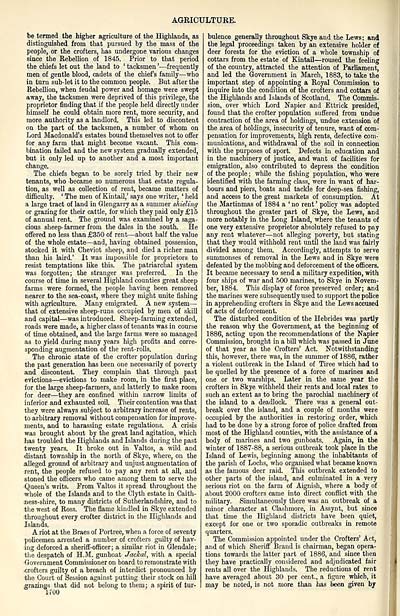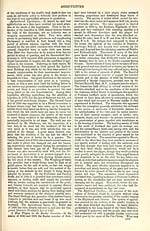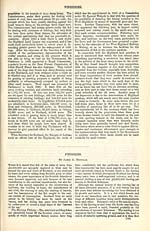Ordnance gazetteer of Scotland
(1708) Page 1700
Download files
Complete book:
Individual page:
Thumbnail gallery: Grid view | List view

AGEICULTURE.
be termed the higher agriculture of the Highlands, as
distinguished from that pursued by the mass of the
people, or the crofters, has undergone various changes
since the Rebellion of 1845. Prior to that period
the chiefs let out the land to ' tacksmen ' — frequently
men of gentle blood, cadets of the chiefs family — who
in turn sub-let it to the common people. But after the
Rebellion, when feudal power and homage were swept
away, the tacksmen were deprived of this privilege, the
proprietor finding that if the people held directly under
himself he could obtain more rent, more security, and
more authority as a landlord. This led to discontent
on the part of the tacksmen, a number of whom on
Lord Macdonald's estates bound themselves not to offer
for any farm that might become vacant. This com-
bination failed and the new system gradually extended,
but it only led up to another and a most important
change.
The chiefs began to be sorely tried by their new
tenants, who became so numerous that estate regula-
tion, as well as collection of rent, became matters of
difficulty. ' The men of Kintail,' says one writer, ' held
a large tract of land in Glengarry as a summer shieling
or grazing for their cattle, for which they paid only £15
of annual rent. The ground was examined by a saga-
cious sheep- farmer from the dales in the south. He
offered no less than £350 of rent — about half the value
of the whole estate — and, having obtained possession,
stocked it with Cheviot sheep, and died a richer man
than his laird.' It was impossible for proprietors to
resist temptations like this. The patriarchal system
was forgotten; the stranger was preferred. In the
course of time in several Highland counties great sheep
farms were formed, the people having been removed
nearer to the sea-coast, where they might unite fishing
with agriculture. Many emigrated. A new system —
that of extensive sheep-runs occupied by men of skill
and capital — was introduced. Sheep-farming extended,
roads were made, a higher class of tenants was in course
of time obtained, and the large farms were so managed
as to yield during many years high profits and corre-
sponding augmentation of the rent-rolls.
The chronic state of the crofter population during
the past generation has been one necessarily of poverty
and discontent. They complain that through past
evictions — evictions to make room, in the first place,
for the large sheep-farmers, and latterly to make room
for deer — they are confined within narrow limits of
inferior and exhausted soil. Their contention was that
they were always subject to arbitrary increase of rents,
to arbitrary removal without compensation for improve-
ments, and to harassing estate regulations. A crisis
was brought about by the great land agitation, which
has troubled the Highlands and Islands during the past
twenty years. It broke out in Valtos, a wild and
distant township in the north of Skye, where, on the
alleged ground of arbitrary and unjust augmentation of
rent, the people refused to pay any rent at all, and
stoned the officers who came among them to serve the
Queen's writs. Prom Valtos it spread throughout the
whole of the Islands and to the Clyth estate in Caith-
ness-shire, to many districts of Sutherlandshire, and to
the west of Ross. The flame kindled in Skye extended
throughout every crofter district in the Highlands and
Islands.
A riot at the Braes of Portree, when a force of seventy
policemen arrested a number of crofters guilty of hav-
ing deforced a sheriff-officer; a similar riot in Glendale;
the despatch of H.M. gunboat Jackal, with a special
Government Commissioner on board to remonstrate with
crofters guilty of a breach of interdict pronounced by
the Court of Session against putting their stock on hill
grazing* that did not belong to them ; a spirit of tur-
1700
bulence generally throughout Skye and the Lews; and
the legal proceedings taken by an extensive holder of
deer forests for the eviction of a whole township of
cottars from the estate of Kintail — roused the feeling
of the country, attracted the attention of Parliament,
and led the Government in March, 1883, to take the
important step of appointing a Royal Commission to
inquire into the condition of the crofters and cottars of
the Highlands and Islands of Scotland. The Commis-
sion, over which Lord Napier and Ettrick presided,
found that the crofter population suffered from undue
contraction of the area of holdings, undue extension of
the area of holdings, insecurity of tenure, want of com-
pensation for improvements, high rents, defective com-
munications, and withdrawal of the soil in connection
with the purposes of sport. Defects in education and
in the machinery of justice, and want of facilities for
emigration, also contributed to depress the condition
of the people ; while the fishing population, who were
identified with the farming class, were in want of har-
bours and piers, boats and tackle for deep-sea fishing,
and access to the great markets of consumption. At
the Martinmas of 1884 a ' no rent ' policy was adopted
throughout the greater part of Skye, the Lews, and
more notably in the Long Island, where the tenants of
one very extensive proprietor absolutely refused to pay
any rent whatever — not alleging poverty, but stating
that they would withhold rent until the land was fairly
divided among them. Accordingly, attempts to serve
summonses of removal in the Lews and in Skye were
defeated by the mobbing and deforcement of the officers.
It became necessary to send a military expedition, with
four ships of war and 500 marines, to Skye in Novem-
ber, 1884. This display of force preserved order; and
the marines were subsequently used to support the police
in apprehending crofters in Skye and the Lews accused
of acts of deforcement.
The disturbed condition of the Hebrides was partly
the reason why the Government, at the beginning of
1886, acting upon the recommendations of the Napier
Commission, brought in a bill which was passed in June
of that year as the Crofters' Act. Notwithstanding
this, however, there was, in the summer of 1886, rather
a violent outbreak in the Island of Tiree which had to
be quelled by the presence of a force of marines and
one or two warships. Later in the same year the
crofters in Skye withheld their rents and local rates to
such an extent as to bring the parochial machinery of
the island to a deadlock. There was a general out-
break over the island, and a couple of months were
occupied by the authorities in restoring order, which
had to be done by a strong force of police drafted from
most of the Highland counties, with the assistance of a
body of marines and two gunboats. Again, in the
winter of 1887-88, a serious outbreak took place in the
Island of Lewis, beginning among the inhabitants of
the parish of Lochs, who organised what became known
as the famous deer raid. This outbreak extended to
other parts of the island, and culminated in a very
serious riot on the farm of Aignish, where a body of
about 2000 crofters came into direct conflict with the
military. Simultaneously there was an outbreak of a
minor character at Clashmore, in Assynt, but since
that time the Highland districts have been quiet,
except for one or two sporadic outbreaks in remote
quarters.
The Commission appointed under the Crofters' Act,
and of which Sheriff Brand is chairman, began opera-
tions towards the latter part of 1886, and since then
they have practically considered and adjudicated fair
rents all over the Highlands. The reductions of rent
have averaged about 30 per cent., a figure which, it
may be noted, is not more than lias been given by
be termed the higher agriculture of the Highlands, as
distinguished from that pursued by the mass of the
people, or the crofters, has undergone various changes
since the Rebellion of 1845. Prior to that period
the chiefs let out the land to ' tacksmen ' — frequently
men of gentle blood, cadets of the chiefs family — who
in turn sub-let it to the common people. But after the
Rebellion, when feudal power and homage were swept
away, the tacksmen were deprived of this privilege, the
proprietor finding that if the people held directly under
himself he could obtain more rent, more security, and
more authority as a landlord. This led to discontent
on the part of the tacksmen, a number of whom on
Lord Macdonald's estates bound themselves not to offer
for any farm that might become vacant. This com-
bination failed and the new system gradually extended,
but it only led up to another and a most important
change.
The chiefs began to be sorely tried by their new
tenants, who became so numerous that estate regula-
tion, as well as collection of rent, became matters of
difficulty. ' The men of Kintail,' says one writer, ' held
a large tract of land in Glengarry as a summer shieling
or grazing for their cattle, for which they paid only £15
of annual rent. The ground was examined by a saga-
cious sheep- farmer from the dales in the south. He
offered no less than £350 of rent — about half the value
of the whole estate — and, having obtained possession,
stocked it with Cheviot sheep, and died a richer man
than his laird.' It was impossible for proprietors to
resist temptations like this. The patriarchal system
was forgotten; the stranger was preferred. In the
course of time in several Highland counties great sheep
farms were formed, the people having been removed
nearer to the sea-coast, where they might unite fishing
with agriculture. Many emigrated. A new system —
that of extensive sheep-runs occupied by men of skill
and capital — was introduced. Sheep-farming extended,
roads were made, a higher class of tenants was in course
of time obtained, and the large farms were so managed
as to yield during many years high profits and corre-
sponding augmentation of the rent-rolls.
The chronic state of the crofter population during
the past generation has been one necessarily of poverty
and discontent. They complain that through past
evictions — evictions to make room, in the first place,
for the large sheep-farmers, and latterly to make room
for deer — they are confined within narrow limits of
inferior and exhausted soil. Their contention was that
they were always subject to arbitrary increase of rents,
to arbitrary removal without compensation for improve-
ments, and to harassing estate regulations. A crisis
was brought about by the great land agitation, which
has troubled the Highlands and Islands during the past
twenty years. It broke out in Valtos, a wild and
distant township in the north of Skye, where, on the
alleged ground of arbitrary and unjust augmentation of
rent, the people refused to pay any rent at all, and
stoned the officers who came among them to serve the
Queen's writs. Prom Valtos it spread throughout the
whole of the Islands and to the Clyth estate in Caith-
ness-shire, to many districts of Sutherlandshire, and to
the west of Ross. The flame kindled in Skye extended
throughout every crofter district in the Highlands and
Islands.
A riot at the Braes of Portree, when a force of seventy
policemen arrested a number of crofters guilty of hav-
ing deforced a sheriff-officer; a similar riot in Glendale;
the despatch of H.M. gunboat Jackal, with a special
Government Commissioner on board to remonstrate with
crofters guilty of a breach of interdict pronounced by
the Court of Session against putting their stock on hill
grazing* that did not belong to them ; a spirit of tur-
1700
bulence generally throughout Skye and the Lews; and
the legal proceedings taken by an extensive holder of
deer forests for the eviction of a whole township of
cottars from the estate of Kintail — roused the feeling
of the country, attracted the attention of Parliament,
and led the Government in March, 1883, to take the
important step of appointing a Royal Commission to
inquire into the condition of the crofters and cottars of
the Highlands and Islands of Scotland. The Commis-
sion, over which Lord Napier and Ettrick presided,
found that the crofter population suffered from undue
contraction of the area of holdings, undue extension of
the area of holdings, insecurity of tenure, want of com-
pensation for improvements, high rents, defective com-
munications, and withdrawal of the soil in connection
with the purposes of sport. Defects in education and
in the machinery of justice, and want of facilities for
emigration, also contributed to depress the condition
of the people ; while the fishing population, who were
identified with the farming class, were in want of har-
bours and piers, boats and tackle for deep-sea fishing,
and access to the great markets of consumption. At
the Martinmas of 1884 a ' no rent ' policy was adopted
throughout the greater part of Skye, the Lews, and
more notably in the Long Island, where the tenants of
one very extensive proprietor absolutely refused to pay
any rent whatever — not alleging poverty, but stating
that they would withhold rent until the land was fairly
divided among them. Accordingly, attempts to serve
summonses of removal in the Lews and in Skye were
defeated by the mobbing and deforcement of the officers.
It became necessary to send a military expedition, with
four ships of war and 500 marines, to Skye in Novem-
ber, 1884. This display of force preserved order; and
the marines were subsequently used to support the police
in apprehending crofters in Skye and the Lews accused
of acts of deforcement.
The disturbed condition of the Hebrides was partly
the reason why the Government, at the beginning of
1886, acting upon the recommendations of the Napier
Commission, brought in a bill which was passed in June
of that year as the Crofters' Act. Notwithstanding
this, however, there was, in the summer of 1886, rather
a violent outbreak in the Island of Tiree which had to
be quelled by the presence of a force of marines and
one or two warships. Later in the same year the
crofters in Skye withheld their rents and local rates to
such an extent as to bring the parochial machinery of
the island to a deadlock. There was a general out-
break over the island, and a couple of months were
occupied by the authorities in restoring order, which
had to be done by a strong force of police drafted from
most of the Highland counties, with the assistance of a
body of marines and two gunboats. Again, in the
winter of 1887-88, a serious outbreak took place in the
Island of Lewis, beginning among the inhabitants of
the parish of Lochs, who organised what became known
as the famous deer raid. This outbreak extended to
other parts of the island, and culminated in a very
serious riot on the farm of Aignish, where a body of
about 2000 crofters came into direct conflict with the
military. Simultaneously there was an outbreak of a
minor character at Clashmore, in Assynt, but since
that time the Highland districts have been quiet,
except for one or two sporadic outbreaks in remote
quarters.
The Commission appointed under the Crofters' Act,
and of which Sheriff Brand is chairman, began opera-
tions towards the latter part of 1886, and since then
they have practically considered and adjudicated fair
rents all over the Highlands. The reductions of rent
have averaged about 30 per cent., a figure which, it
may be noted, is not more than lias been given by
Set display mode to: Large image | Transcription
Images and transcriptions on this page, including medium image downloads, may be used under the Creative Commons Attribution 4.0 International Licence unless otherwise stated. ![]()
| Gazetteers of Scotland, 1803-1901 > Ordnance gazetteer of Scotland > (1708) Page 1700 |
|---|
| Permanent URL | https://digital.nls.uk/97413742 |
|---|

